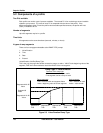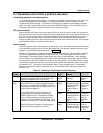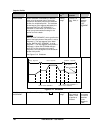
Setpoint Profiler
Video Recorder – User Manual 185
5.3 Parameters that control a profile’s execution
Coordinating operation of multiple profilers
In a multi-profiler instrument the profiles in a program can be totally unrelated to each other, that is, you
can give them different times and settings. If you want the profilers to be coordinated, you must
configure each profiler that way. For example, if you want all your profilers to be started by the same
signal, you must configure each profiler with the same START parameter. The Copy Block function in
the Program menu lets you copy parameters from one profiler to another.
SPP synchronization
Allows a multiple SPP user to synchronize several SPPs for when one enter hold due to a guaranteed
hold, the others will enter hold and when the one that entered hold leaver hold the others will leave hold
also. This is done by using a block output status called SG (status guaranteed hold) that is high when
the block is in guaranteed hold mode. If different SPPs are used, the SPPx SG outputs should run
through an OR block and then the output of the OR block back to the SPPx HOLD input. The SG status
output may be viewed on the discrete status screen.
Discrete inputs
You can program a profiler with discrete inputs that enable you to reset, start, hold, advance, shut down,
or fast forward through the profiler, hot start the profiler from a live process variable, increment a ramp
segment, or enable/disable guaranteed soak. See
Table 5-2.
Note that some discretes are edge-sensitive and some are level-sensitive. Edge-sensitive means that
the action is triggered by the discrete’s transition from OFF to ON (rising edge) or from ON to OFF
(falling edge). The changing status is what triggers the action, not the status itself. Some discretes,
such as START, are rising edge-sensitive only and are not affected by a falling edge. When START’s
discrete goes ON, the profiler starts to run; when the discrete goes OFF, the profiler continues running.
Level-sensitive means that one action occurs while the discrete is ON and another action occurs while
the discrete is OFF. The status is what causes the action, not the changing status. Fast forward’s
discrete is level-sensitive; that is, the profiler will run in fast forward while the discrete is ON but not
while it is OFF.
Table 5-2 Parameters That Control Profiler Execution
Paramet
er name
Definition Triggere
d by
Conditions
present
Result
START Starts Profiler from Ready, Hold, or End state.
Activated by operator menu or by discrete input.
May be connected to the F1 key (SY1F1).
Rising
edge
Profiler in Ready or
End state
Profiler
starts to
Run.
RESET/
RUN
The behavior of this parameter depends on START.
If the START discrete input is programmed with a
discrete, then switching RESET/RUN from OFF to
ON resets an Ended, Hold, or Ready profiler to the
starting value of segment 1.
Rising
edge
Start is
programmed with a
discrete parameter
& profiler is in
Ready or Hold or
End
Profiler
changes to
Ready and
goes to
Segment
#1.
If the START discrete input parameter is not
programmed with a discrete, then switching
RESET/RUN from OFF to ON resets an Ended,
Hold, or Ready program to the starting value of
segment 1 and to the profiler’s Ready state. On a
transition from ON to OFF, starts an Ended profiler.
Rising
edge
START is not
programmed with a
discrete parameter
& profiler is in
Ready or Hold or
End
Profiler
changes to
Ready and
goes to
Segment
#1.
RESET/RUN does not affect a running program.
May be connected to the F3 key (SY1F3).
Falling
edge
START is not
programmed with a
discrete parameter
& profiler is at End
Profiler
goes to
Segment #1
and starts
to Run.


















